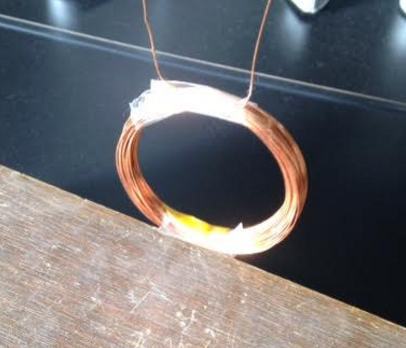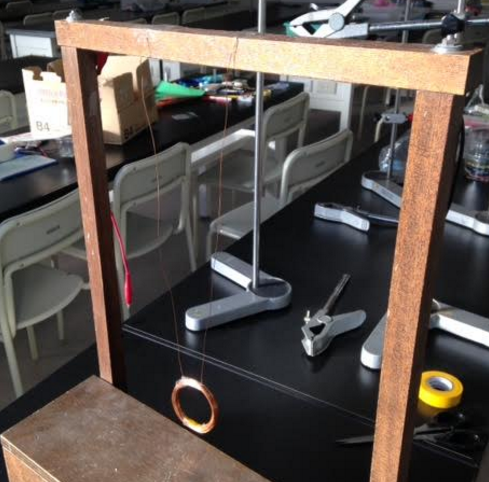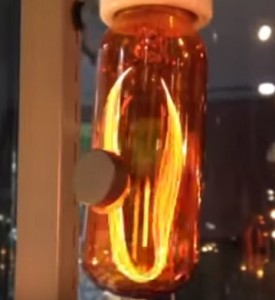Why Does the Magnet Stop It? Unveiling the Secret of “Change-Hating Electricity” with a Coil Swing Experiment!
I’m Ken Kuwako, Science Trainer. Every day is an experiment.
Imagine a piece of metal stopping dead in its tracks without anything touching it. Doesn’t that sound like science fiction or magic? What if I told you you could easily experience this phenomenon using just items you already have at home? Today, I’m sharing an experiment recipe that you can do right away at home and is guaranteed to amaze you!
The key to this phenomenon is the “eddy current.” While the term might sound unfamiliar, eddy currents are actually very close to us and support our daily lives. A great example is the “eddy current brake” used in Shinkansen (bullet trains), some regular trains, and roller coasters at amusement parks. The incredible thing about this brake is that it can stop wheels without any physical contact between parts—it’s like magic! Since it involves no friction, it offers major advantages such as stable braking even on rainy days and minimal wear and tear on parts.
Today, I’ll introduce an experiment that unravels the true nature of these magical eddy currents!
The Science Recipe
● What You Need
- Copper wire (insulated wire like magnet wire is easier to handle)
- A core to wrap around (such as an empty can or a cardboard tube from plastic wrap)
- A magnet
- Alligator clips (or cellophane tape), if available
Regarding the magnet, a strong one like a neodymium magnet is ideal, but several stacked round ferrite magnets sold at 100-yen shops will also work. The more conductive the copper wire is, the more pronounced the following phenomenon will be.
● Procedure
① First, create a coil. Use a cylinder, like an empty can, to wrap the copper wire around. A thin can, such as one for soda, is recommended. Wrap it about 20 times. (Note: If using magnet wire, scrape off the insulation at both ends with sandpaper or a utility knife.)

② Hang the coil to create a pendulum (swing). Secure it to something so the coil can swing like a pendulum.

③ Let the pendulum swing naturally. First, let it swing normally. Naturally, it will continue swinging for a while. Next, connect the two ends of the copper wire using alligator clips or tape (closing the circuit) and observe. Since there is no magnet yet, you should see no change.
④ Now, place the magnet near the coil and repeat step ③. Position the magnet so that when the coil pendulum swings, the magnet approaches and moves away from the “side” of the coil, rather than passing through the coil’s loop. Then, repeat the observation from step ③.

● The Result
Please check out this video.
It’s astonishing! When the magnet is present, the moment you complete the “circuit” by connecting the ends of the copper wire, the pendulum suddenly stops, as if it were moving through molasses. You didn’t connect any battery or power source, so why does it stop? It’s truly baffling!
The True Nature of the Magic – Why the Brake Engages
The secret behind this phenomenon lies in “electromagnetic induction” and the subsequent “tendency of electricity to oppose change” (Lenz’s Law).
- Electricity is Born (Electromagnetic Induction) As the coil (copper wire) moves past the magnet (approaches and moves away), the strength of the magnetic field inside the coil changes. According to “Faraday’s Law of Electromagnetic Induction,” which you learn in science class, this “change” generates a force (voltage) that tries to push an electric current through the coil.
- When the Circuit is Closed… The key point of this experiment is connecting the two ends of the copper wire (closing the circuit). Although the force attempting to push current is generated, electricity can’t flow if the path isn’t connected. However, by connecting the ends, the generated force causes an “induced current” to flow within the coil.
- The Brake Engages (Lenz’s Law) Here’s the most interesting part. The current that flows at this moment has a very “contrary” nature, known as Lenz’s Law.
- When the coil tries to approach the magnet → It generates a repulsive magnetic force, saying, “Don’t come near!” and opposes the motion.
- When the coil tries to move away from the magnet → It generates an attractive magnetic force, saying, “Don’t go!” and still opposes the motion.
In short, no matter which way the coil tries to move, a force (brake) is generated to scream, “Halt!” This is the principle behind the “eddy current brake” that stops objects without touching them. The phenomenon that looked like magic was actually the power of electricity working hard to oppose “changes in the magnetic field.”
[Advanced] Experiencing Eddy Currents with a Spinning Top
You can also experience this eddy current brake using a metallic disc, like a gyroscope or a spinning top. This time, the electricity flows not through a coil, but within the metal “plate” itself.
When you bring a magnet close to a spinning top (a metallic disc), a “swirling current”—the eddy current—is generated within the disc. This eddy current is also “contrary.” Since it applies a brake to oppose the “change” in the top’s rotation, you’ll see the spinning top gradually slow down and stop just by bringing a magnet near it.
While the previous experiment showed a current flowing along a “copper wire path,” this one shows a current swirling throughout the entire “metal plate.” Both are critical scientific principles supporting our safe daily lives. Be sure to try this “magic brake” experiment at home!
Inquiries and Requests
Bring the wonders and fun of science closer to you! I’ve put together easy-to-understand tips and fun science experiments you can do at home. Feel free to search around! ・My science notes have been published as a book. Find out more here ・About the operator, Ken Kuwako: Click here ・For various requests (writing, lectures, science classes, TV supervision, appearances, etc.): Click here ・Article updates are delivered on X!
![]() Experimental videos are available on the Science Topics Channel!
Experimental videos are available on the Science Topics Channel!


